A Liberatory Infrastructure Learning Deck
Mixed Metaphor
Card Deck
-
A Blessing & Welcome: About the Deck
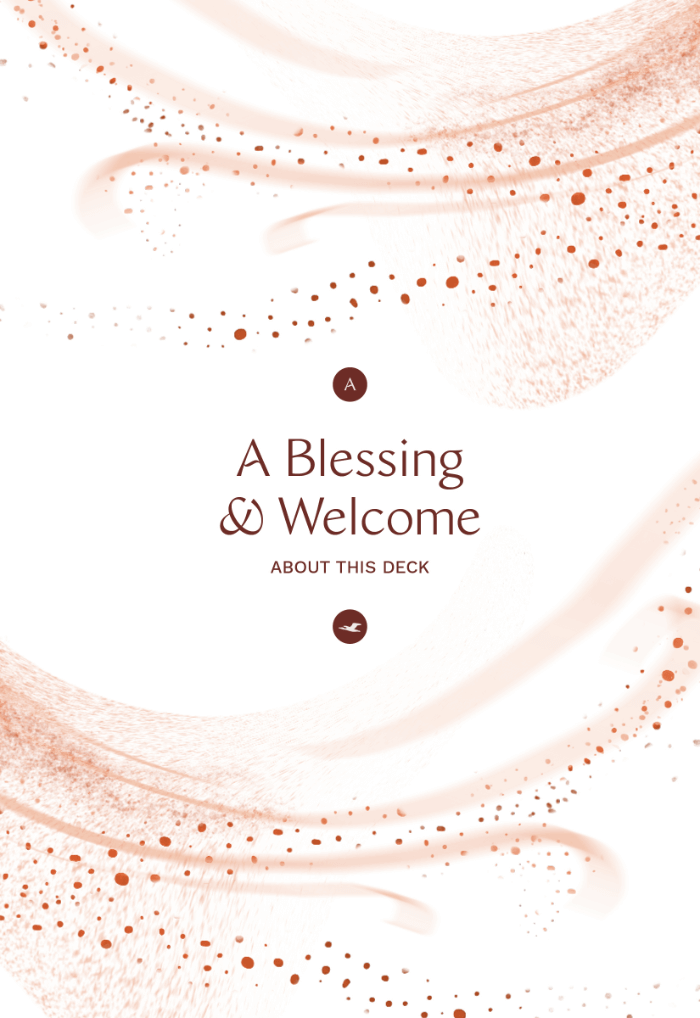 A
AA Blessing & Welcome
Welcome, co-creator. Welcome, friend. This deck and its companion workbook were created by the artists, poets, dreamers, arts administrators, organizational leaders, and visionaries of Leveraging a Network for Equity (LANE) seeking to amplify the leadership of arts organizations of color and rural organizations to bolster a thriving and innovative field. Use these cards individually and in groups to reinforce your work of shifting and dismantling systems of oppression while creating liberating alternatives and new worlds within yourselves, your organizations, and your networks.
Some places to start…
- Pull a card to read out loud to yourself or to a group. What is important about the learning on this card right now? How might it apply to your work?
- Ask a question and pull a card. How might the offerings on the card support you in answering this question? How might they support you in creating your next question?
- Pull a card from each of the four main suits (Invitations, Sacred Seven, Cornerstones, and Liberating Practices). What is the story that unfolds? What meaning do you make of it?
The Suits
Each of the four suits in this deck offer a different element of the LANE cohort members’ learning about what it takes to transform yourself, your organization, and the sector towards racial justice and cultural equity. Together, the suits invite us to reflect, deepen practices, surface new learnings and questions, and try new or remembered ways of being and doing. They are:
- Invitations. Through poetry, song, dreaming, and reflection, this suit invites you into the concepts, ways of knowing, and ways of being foundational to the LANE journey.
- Sacred Seven. This suit supports you to engage with the seven areas of learning and practice central to LANE, which are rooted in cohort members’ lived experience and uplifted from the actions, practices, and decisions that transformed them and their organizations. Calling these areas sacred honors the emotional and practical labor that has gone into creating this offering of generative possibility.
- Cornerstones. By grounding you in the principles of the LANE initiative, this suit guides you to deepen your understanding and praxis of these principles.
- Liberating Practices. The practices offered in this suit support living the vision of LANE today. They uplift human dignity by offering alternatives to white supremacy culture and habits and remind us that we are always at choice in our practices even when the systems and barriers around us would have us believe otherwise.
A -
The Sacred Center: Invitations
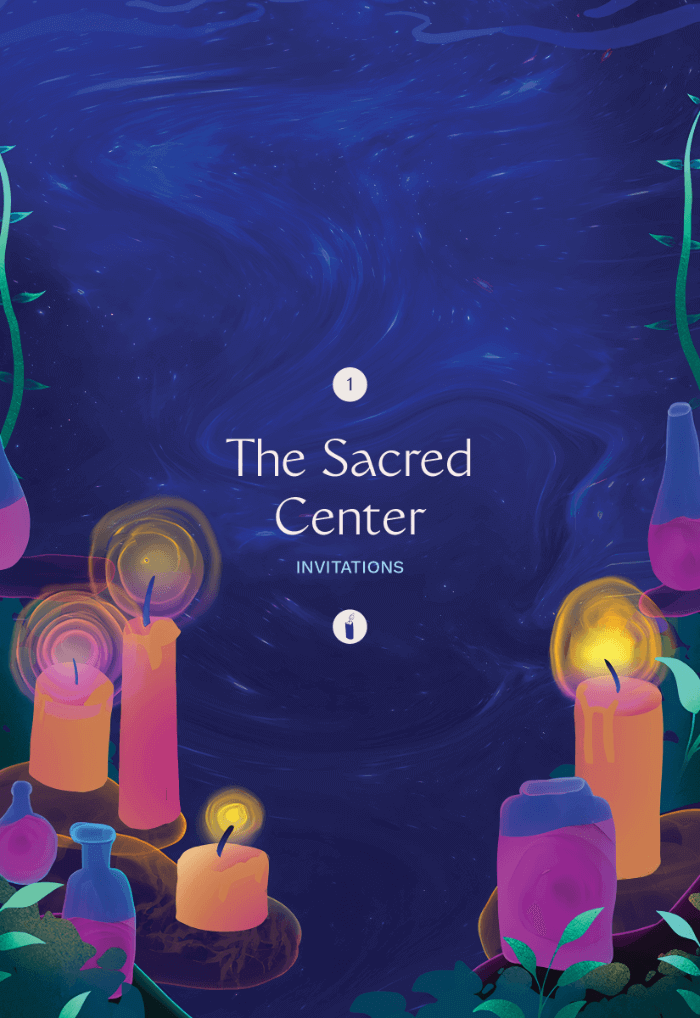 1
1The Sacred Center
“The sacred is what’s possible when we all have what we need to show up as our best selves in our relationships to self, each other, and the planet, and to return to that best self when we are not there for whatever reason.”
—Elissa Sloan Perry Together, organizations in LANE are calling the arts ecosystem toward what becomes possible for people and communities with an arts sector rooted in racial justice and cultural equity. In this vision, arts organizations of color and rural arts organizations are strong, healthy, and adaptive, and their leadership is amplified, recognized, and resourced for their critical culture work that dismantles systems of oppression and co-creates liberating alternatives.
Poem title: Moving to the Sacred Center I hear multiple languages and multiple ways of expression.
I see artists living with sustainable income.
I feel the warmth of our community and the circle of our many realities.
I smell the fire in the lamp oil that makes it a sacred space.
I taste abundance of food of many cultures.—Pangea World Theater - What is your deepest desire for your community and/or organization? For the arts sector? For the world?
- What from the past is propelling you? What from the future is drawing you?
1 -
Carry Our Gifts with Conviction: Invitations
 2
2Carry Our Gifts with Conviction
“The beauty of the partnership is that each plant does what it does in order to increase its own growth. But as it happens, when the individuals flourish, so does the whole… The most important thing each of us can know is our unique gift and how to use it in the world. Individuality is cherished and nurtured, because, in order for the whole to flourish, each of us has to be strong in who we are and carry our gifts with conviction, so they can be shared with others. Being among the [three plants] provides a visible manifestation of what a community can become when its members understand and share their gifts. In reciprocity, we fill our spirits as well as our bellies.”
—Robin Wall Kimmerer, Braiding Sweetgrass - What unique gifts will support you in transforming yourself and your organization in alignment with racial justice, cultural equity, and liberation?
- What unique gifts will you offer as we co-create an arts ecosystem rooted in racial justice and cultural equity?
2 -
Connection to People & Place: Invitations
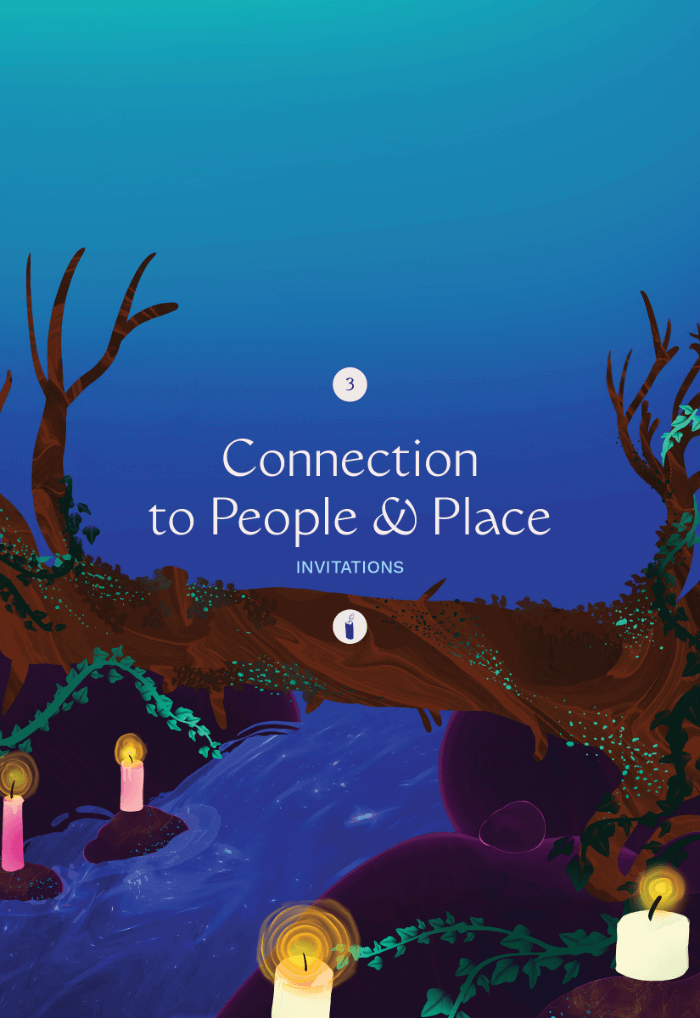 3
3Connection to People & Place
Poem title: Bringing Black BackI see neighborhoods of houses owned by the Black descendants of those who built them.
I hear loud music and laughter in the streets,
not drowned out by police sirens
I feel the love of families and communities gathering together in ways that remind us of our common humanity.
I smell the water where the river and ocean meet,
reminding me of all the ancestors who came before us.
I taste the sweetness of “ancient thoughts being brought to present thinkers so future generations can be healed.” (Sunni Patterson)—Junebug Productions Poem title: Our PlaceI hear my community’s stories and songs and laughter
and tears and deepest fears.
I smell chiles on the grill, beer on the floor, and the perfume and hairspray of the viejitas at the Sunday matinee.
I taste the canela in the coffee, abuela’s chocolate and tamales that are part of every show.
I see a full house of mothers and daughters, abuelas and abuelos, nietos, hijos climbing over seats, suddenly brought quiet and engaged.—Su Teatro Cultural and Performing Arts Center - What people, place, land, community, and political lineages anchor your vision for the future? How are your actions aligned with your lineages?
- How does this anchoring and alignment impact how you move through the world?
3 -
Detoxify Systems of Oppression: Invitations
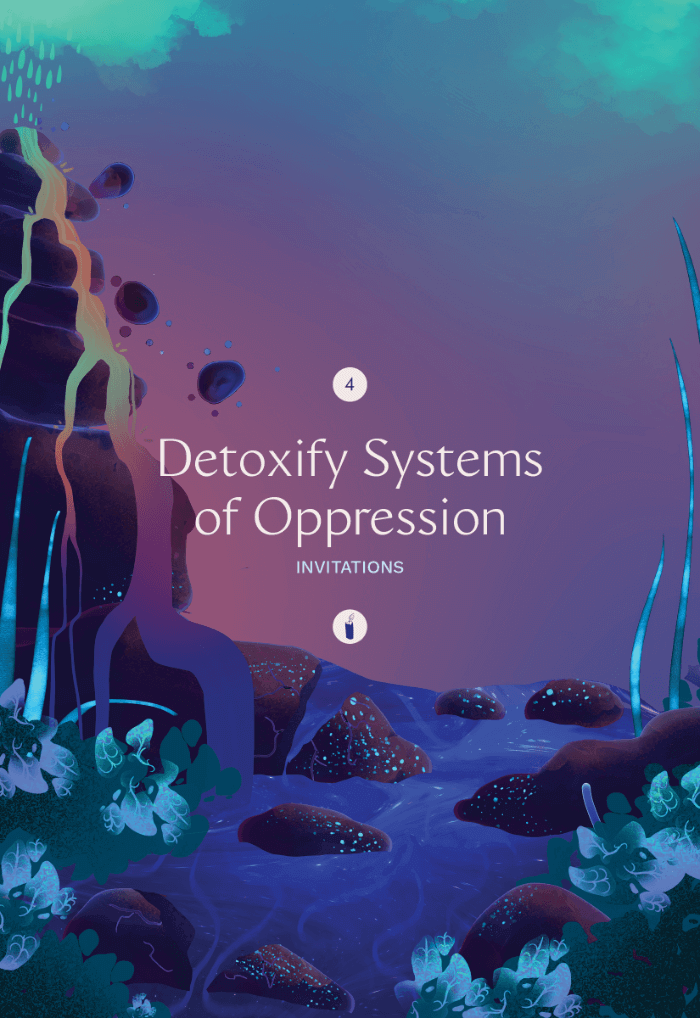 4
4Detoxify Systems of Oppression
““It’s not about the lack within these organizations; it’s not [that they are] at risk. It is: these folks are brilliant and they are living inside a toxic system. How do we uplift their brilliance and how do we detoxify the system?”
—Sage Crump “I had an idea about how we could make change within systems, and now I have a strong desire to dismantle those systems. In a big way, that looks like being in a region where the sharecroppers union was thousands of people strong, and then, in a smaller way, a micro-way, it’s understanding that the issues with my organization aren’t about the leader but about a hierarchical model.”
—Jackie Clay, Coleman Center for the Arts Arts organizations of color and rural arts organizations have experiences of systemic devaluing, divestment, and undercapitalization to a larger degree than other organizations in the sector. Advancing racial justice and cultural equity means tearing down systems of oppression— white supremacy culture and racial capitalism—at the root of these current and historic inequities. It also means looking for and building new riverways, pathways, and treeways to equity. Like water, these pathways can change shape and are mutable because we are trying to build something that is not like how it was before.
- How are you developing and deepening your understanding of the ways various systems of oppression function, not just their impact?
- In what ways does your work detoxify and dismantle systems?
4 -
Ready to Fly: Invitations
 5
5Ready to Fly
I just can’t keep still
And I’ll tell you the reason why
When the movement comes
I want to be ready to fly
I want to be ready
I want to be re-e-eady
I want to be re-e-eady
Ready to walk this freedom road
Ready to walk this freedom road—Adaptation of a Civil Rights Movement Song - Say the words above out loud, humming as you go. Where do you feel these words in your body?
- What helps you understand that change is on us? What do you need to be ready? What do you feel like you need to be ready for?
5 -
Tenets of Principled Struggle: Invitations
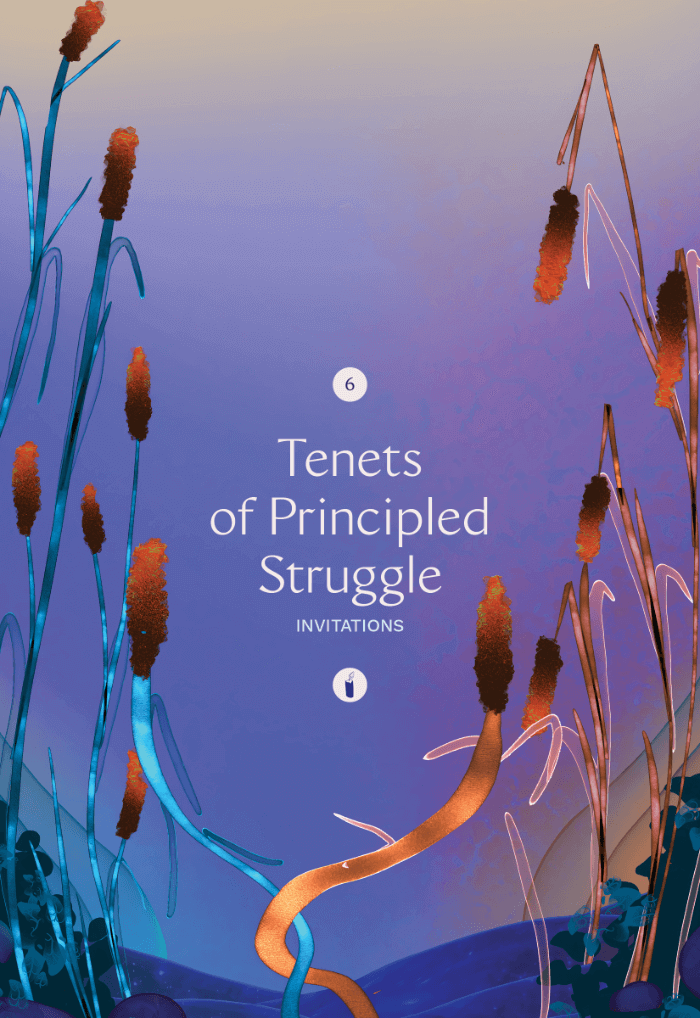 6
6Tenets of Principled Struggle
Be honest and direct with compassion.
Take responsibility for your feelings and actions.
Struggle to deepen understanding and unity.
Seek deeper understanding… Ask/Read 1st.
Consider this may or may not be the container you need.
Side conversations should build, not divide or check out.—N’tanya Lee, Based on the Work of Mao Tse-Tung,
npnlane.org/combat-liberalism- How do you navigate tension and challenges among people you share values with?
- How might you embrace and practice these tenets? What might emerge from these practices?
- How might you bring these tenets into your organization? Your networks? Your community?
6 -
Vision Dreams: Invitations
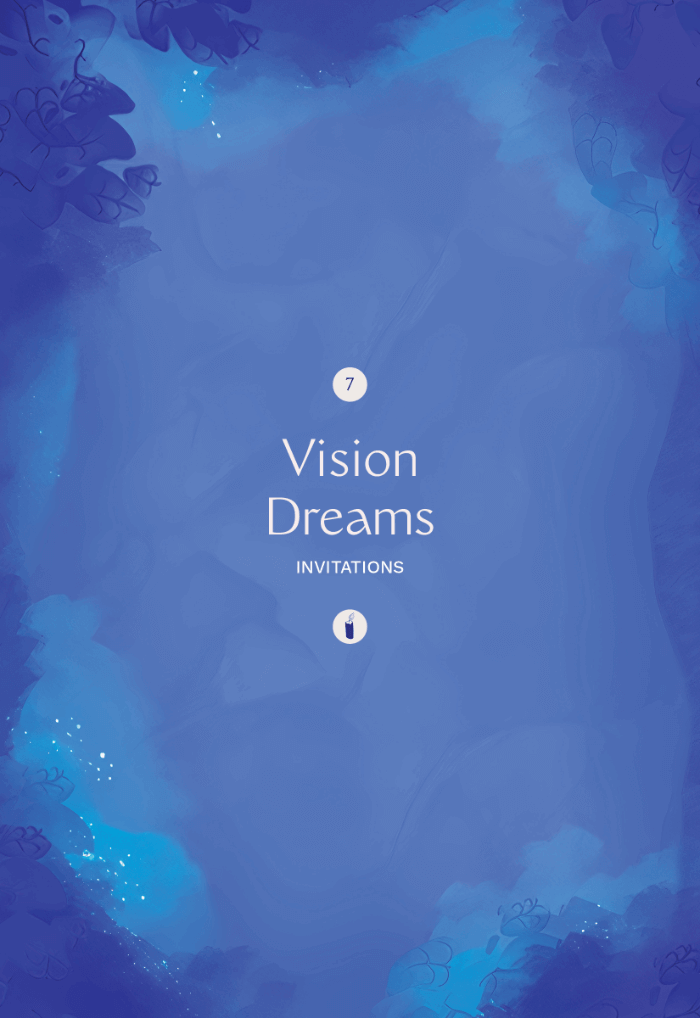 7
7Vision Dreams
Poem title: The Next Fifty YearsI see the future in the past. We bring the best things forward, sankofa.
I feel new possibilities made real through teamwork and collaboration, intergenerationally.
Moved by vibration, our movement rises to press the earlobes of our community and our society to create art, justice, and music that we all hear.
The smell of fresh-cut wood building structures for a new dwelling devoted to our practice of revealing, reclaiming, and reframing, and I taste the honey on my tongue as I watch the dream become reality.—The Carpetbag Theater, Inc. The pathway to an equitable arts ecosystem requires space to dream and imagine our vision for ourselves, our communities, our networks, and the arts sector together—visions rooted in joy, freedom, and liberation. Dreams nourish us and generate multiple possibilities for the future while simultaneously living it today. Dream with us…
- Use the prompts below to co-create a poem that brings the future to life in your senses.
- What does the future you or your organization envision... look like? sound like? smell like? taste like? feel like?
- Where does your dream meet reality and your reality meet your dream?
7 -
Leadership: The Sacred Seven
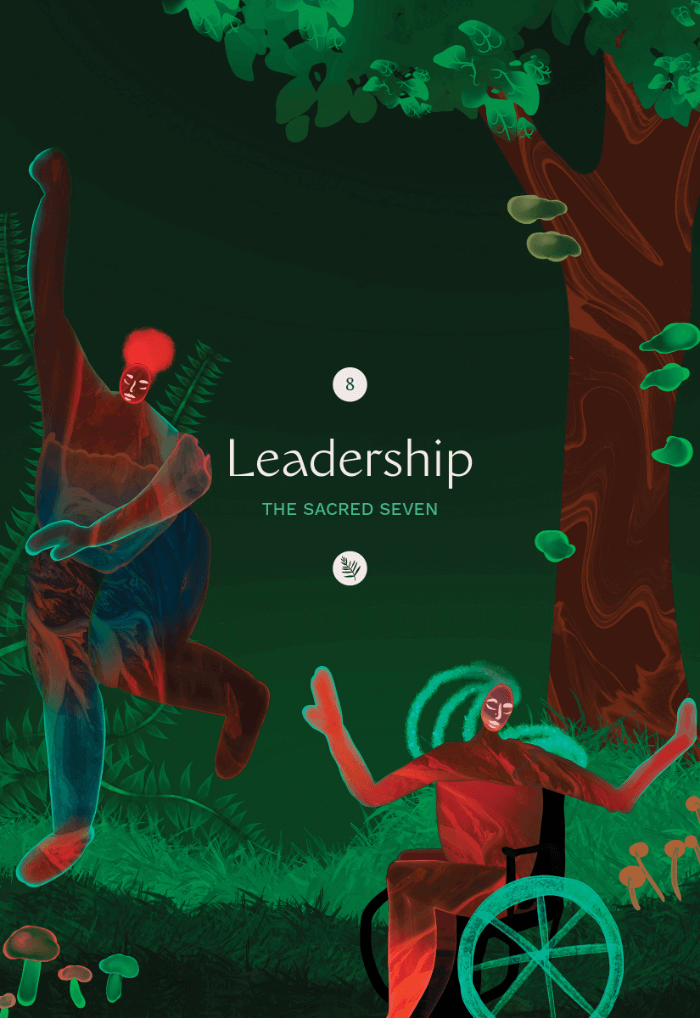 8
8Leading Toward Racial Justice & Cultural Equity
“We are cultivating a new way of holding space and of being, which embraces many ways of knowing and doing work—and which accords respect and dignity to all. This means acceptance of multiple truths, even when they contradict each other. Humility and conscientiousness [are] vital, as well as a willingness to open ourselves to constant new understandings.”
—Dipankar Mukherjee, Pangea World Theater Leadership is the practice of choosing the path of racial justice and cultural equity for people and the planet. It is not a singular person or even a group of people but a set of approaches, capacities, relationships, and people needed to support teams, advance missions, grow more leadership, dismantle toxic systems, and create liberating alternatives.
- What does leading towards racial justice and cultural equity look like for you and your organization?
- How does your practice of leadership embody racial justice and cultural equity?
8 -
Relationships: The Sacred Seven
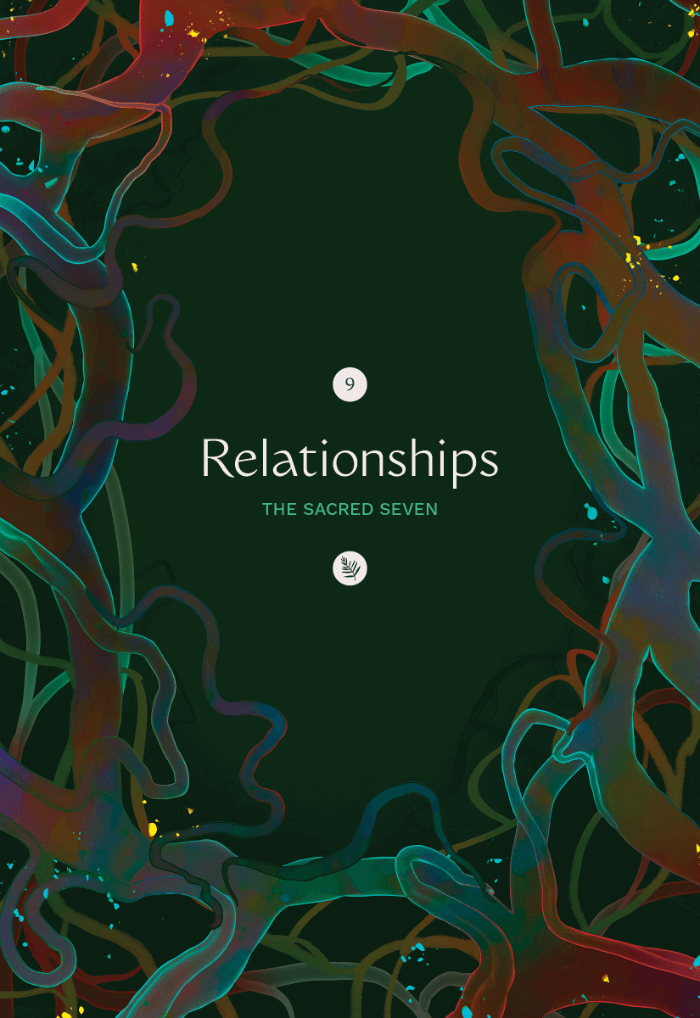 9
9Rooting in Relationships
“[A banyan tree’s branches] slowly grow until they become roots underground [and] even if one part is injured, [the roots] can connect and heal it.”
—Meena Natarajan, Pangea World Theater Deep relationships provide resilience and can be a source of energy as they nourish, heal, and support us in turning our toxic conditions into thriving, powerful ecosystems. When relationships bloom, systems transform in alignment with the vision and values that nourish them.
- Draw your personal ecosystem. Where do you go for what you need? What connections heal and nourish?
- How are you tending to care, connection, spaciousness, and healing within the roots of your relationships? Your communities? Your networks?
 ↑ Tension ↓
↑ Tension ↓ 
When conflict surfaces, practicing honesty with compassion and transparency, and sitting with the tensions related to power, access, and privilege, are critical to being in a continued relationship that generates a different and desired future.
- What supports you to be in generative conflict?
- What skills and capacity do you have to engage in principled struggle? What growth opportunities do you see?
9 -
Transformation: The Sacred Seven
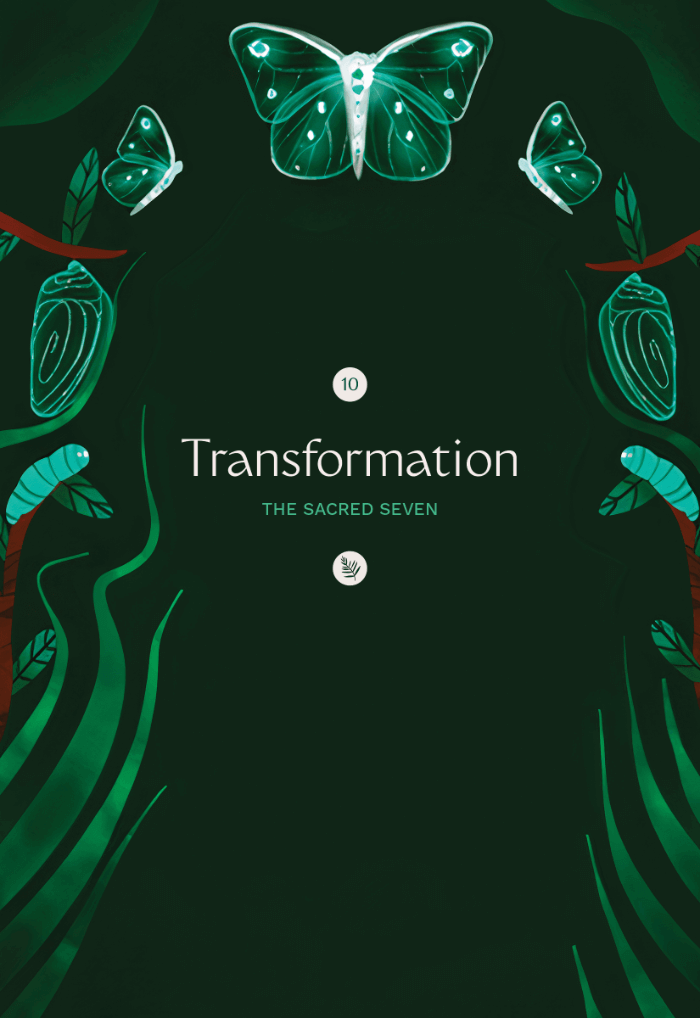 10
10Transformation
“Transform yourself to transform the world.”
—Grace Lee Boggs Transformation—change that can’t easily be changed back—towards racial justice and cultural equity holds that the process of change is just as important as the outcomes. In other words, the long, iterative, intentional, and often slow-moving work within the butterfly’s chrysalis is just as important as the form of the butterfly. Transformation connects the concepts of risk and faith—does a caterpillar go in knowing it will be completely undone and become a butterfly?
- How are you or your organization already embodying your desired future?
- What are you shifting, shedding, or creating to more fully embody your desired future? What are you learning from that process?
10 -
Risk: The Sacred Seven
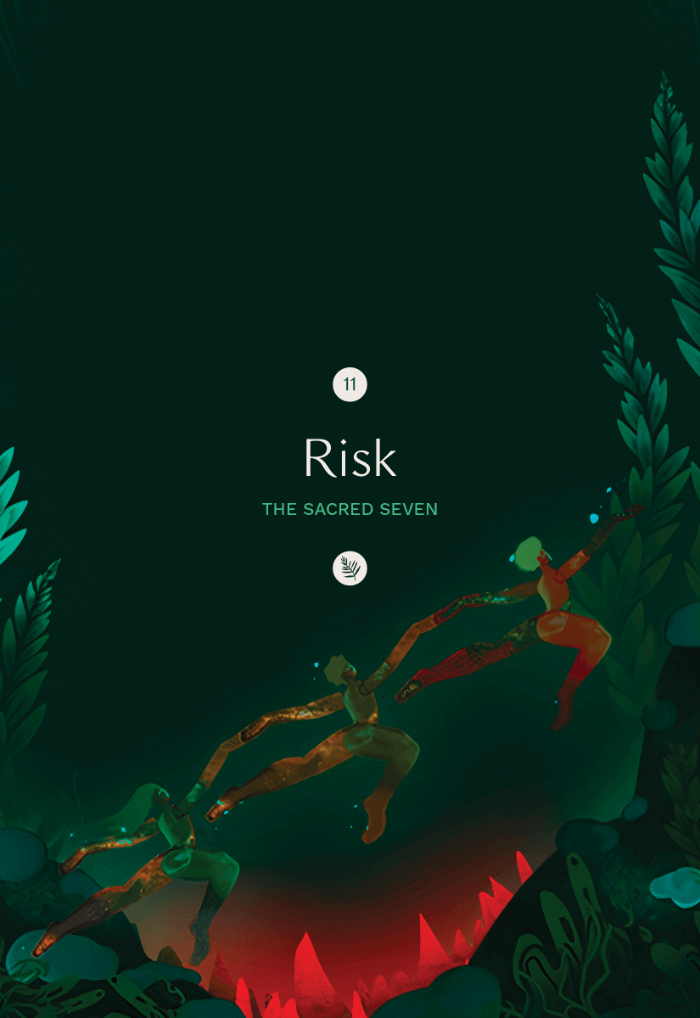 11
11Holding Chance, Together
“Discomfort is the seed of growth and change.”
—Nina Yarbrough, Central District Forum for Arts & Ideas Risk is a leap. It is an action of values-centered decision-making to boldly advance a vision. White supremacy culture and racial capitalism are designed to intentionally inhibit risk-taking that advances a vision that dismantles these very systems. Risk-taking asks us to be vulnerable, embrace emergence and our mistakes, and firmly connect to our power—despite the barriers and uncertainties that lay ahead—to leap together toward the next world now.
- What is your own discomfort with taking risks trying to seed instead?
- How are your risks, either those you are taking individually or collectively, informed by experience, historical and current context, and culture?
- How might your team move forward when there are different relationships to risk within?
- What supports your organization, networks, and communities in holding chance to leap towards your vision together?
11 -
Organizational Culture & Power: The Sacred Seven
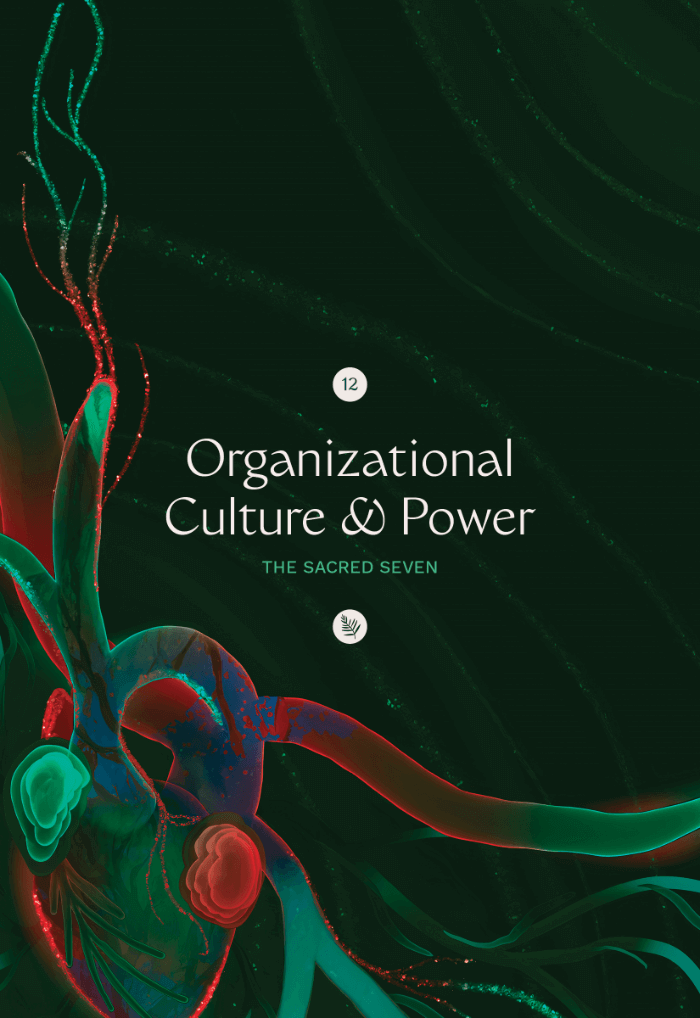 12
12Building Power With[in]
“We live in capitalism. Its power seems inescapable. So did the divine rights of kings.”
—Ursula K. Le Guin “When organizations are in crisis [as they are now in the pandemic], it’s the community that responds… Despite being the smallest and only minority-owned theater in Durham, Hayti is doing better than several other theaters. We’re the engine that could. We’re planning events. We’ve been doing things and engaging. Our impact on community is important because it’s the community that decides how to respond.”
—Angela Lee, Hayti Heritage Center Power and resilience aren’t rooted in size or financial resources but in community relationships and values. The cultural practices that build organizational power are community-based, intergenerational, and rooted in values of interdependence, equity, and abundance. These cultural practices equip us with what we need to dismantle and shift systems like racial capitalism, cultural inequity, and white supremacy. Power built by community and culture is an infinite resource.
- When are you or your organization rooted firmly in your power? When do you or your organization give your power away?
- What are the power-building practices of your communities, cultures, ancestors, and people that you can draw upon?
12 -
Organizational Capacity & Infrastructure: The Sacred Seven
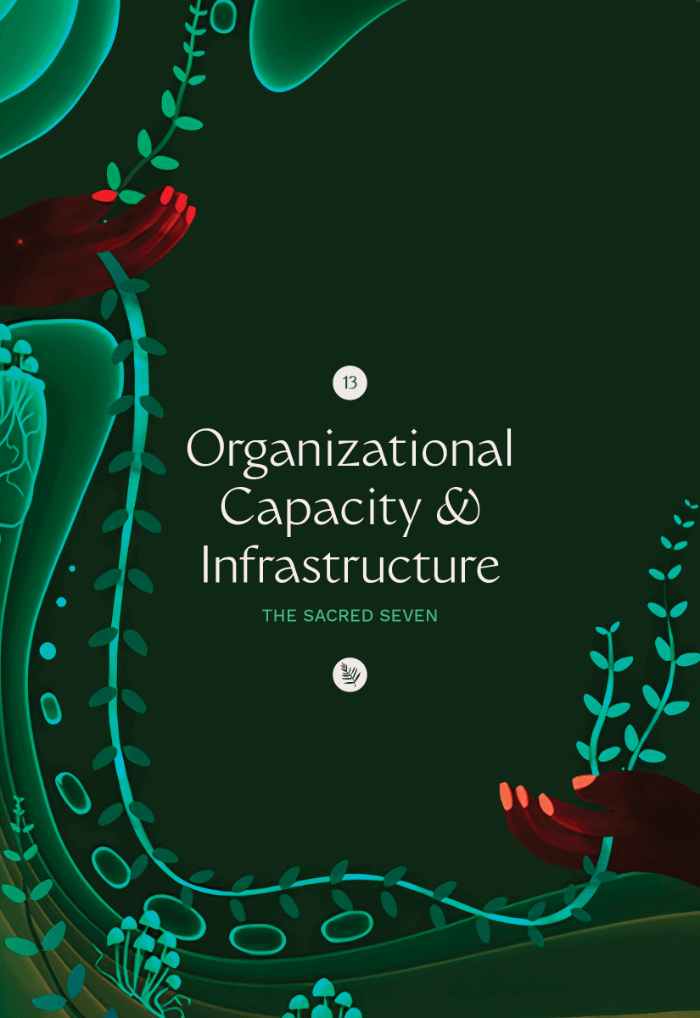 13
13Reimagining Capacity & Infrastructure
“Often in our field, it is this deficit model that we all have something that needs to be fixed within our organizations instead of recognizing the strength, power, and resilience that we bring to the work we do.”
—Anjee Helstrup-Alvarez, Movimiento De Arte y Cultura Latino Americana (MACLA) Our organizations already have what is needed to thrive, but there are personal and systemic barriers in the way—barriers upheld by white supremacy culture and racial capitalism. By leading with strengths, and guided by our vision and values, we can create infrastructure and capacities that disrupt these systems of oppression and center racial justice and care for our organizations and the people in them. Together, we can reimagine what is needed to nourish and sustain equitable and powerful arts institutions.
- Imagine a thriving and equitable organization. What does it look like? How does it function? What infrastructure is supporting it to thrive? What needs to be built?
- In that same imagined field, where could your power, gifts, and wisdom be leveraged to strengthen the organization? What about this imagined relationship between the self and the organization feels freeing, affirming, and flourishing?
13 -
Influence: The Sacred Seven
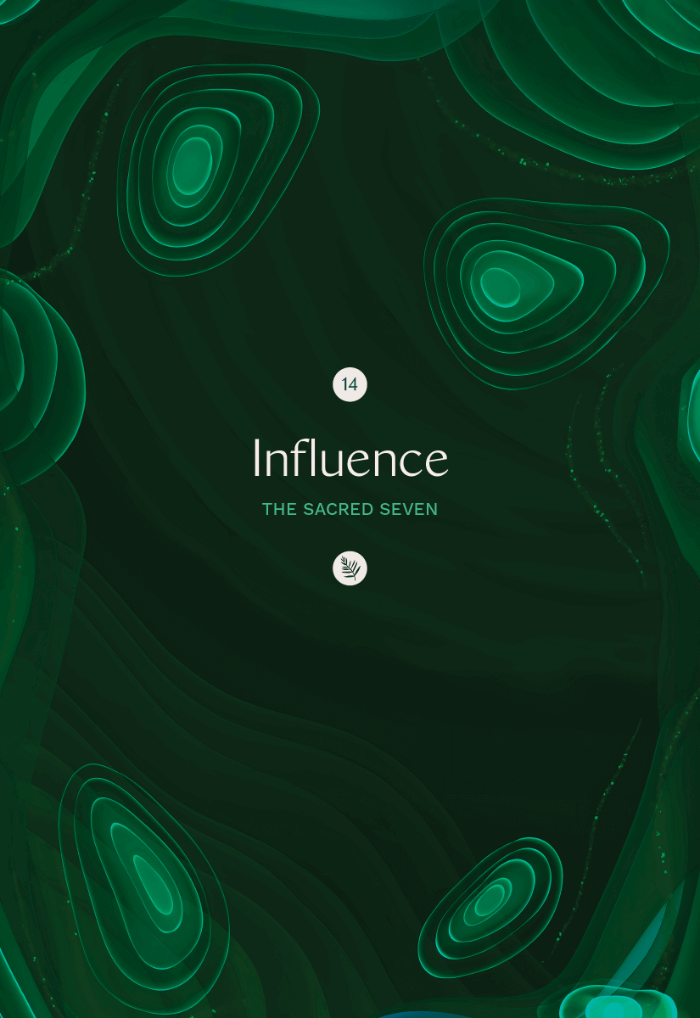 14
14Ripples to Waves: Building Power for Racial Justice & Cultural Equity
“We, as creative people, have the capacity to create a different ending to the story; explore the context, allow room to acknowledge layers, imagine possible outcomes… and the process of connecting with our stories makes me realize that this is the very work we’ve been doing for 40 years.”
—Lane Cohort Member Like water in a tide pool, powerful change ripples both out and around spheres of influence, creating waves that move in different directions—pushing, pulling, and moving elements of the ecosystem. Some of the most enduring, far-reaching ripples come from the ways individuals transform themselves. To build power in their ecosystems, leaders honor, leverage, and (re)claim their own power by first transforming themselves in alignment with their vision and values—catalyzing ripples of change in their organizations, networks, communities, and movements. If movements come in waves, together we can build the power to generate and galvanize the next swell.
- How are you building your own power in order to influence your ecosystem?
- In your own work, where is change rippling out, toward, and around? What moves it? What is the next big swell your work is galvanizing?
14 -
Emergence: Cornerstones
 15
15Emergence
“Transformation doesn’t happen in a linear way, at least not one we can always track. It happens in cycles, convergences, explosions. If we release the framework of failure, we can realize that we are in iterative cycles, and we can keep asking ourselves—how do I learn from this?”
—adrienne maree brown “Emergence is the way complex systems and patterns arise out of a multiplicity of relatively simple interactions,” described Nick Obolensky. Emergence guides us to:
- Embrace complexity to find sustainable strategies: Change is nonlinear and iterative, generating possibilities for transformation towards equity with each turn, failure, and adaptation.
- Practice systems thinking: Equitable systems change transforms inequitable structures and the underlying power dynamics and narratives that build them.
- Engage with fractals: The small mirrors the large and vice versa. Smaller interactions or shifts in organizations and groups impact systems and ideas upholding white supremacy.
- Work with a sense of scale: Zoom in and out from your organization to the systems you are in, working to dismantle white supremacy and racial capitalism at multiple levels.
- Focus on how you are creating change, not only what you’re changing: Every day is an opportunity to live your vision now.
- When is complexity and emergence more comfortable for you? Less comfortable?
- What changes can you make in your relationships, organizations, or networks that can shift systems?
15 -
Racial Justice & Cultural Equity: Cornerstones
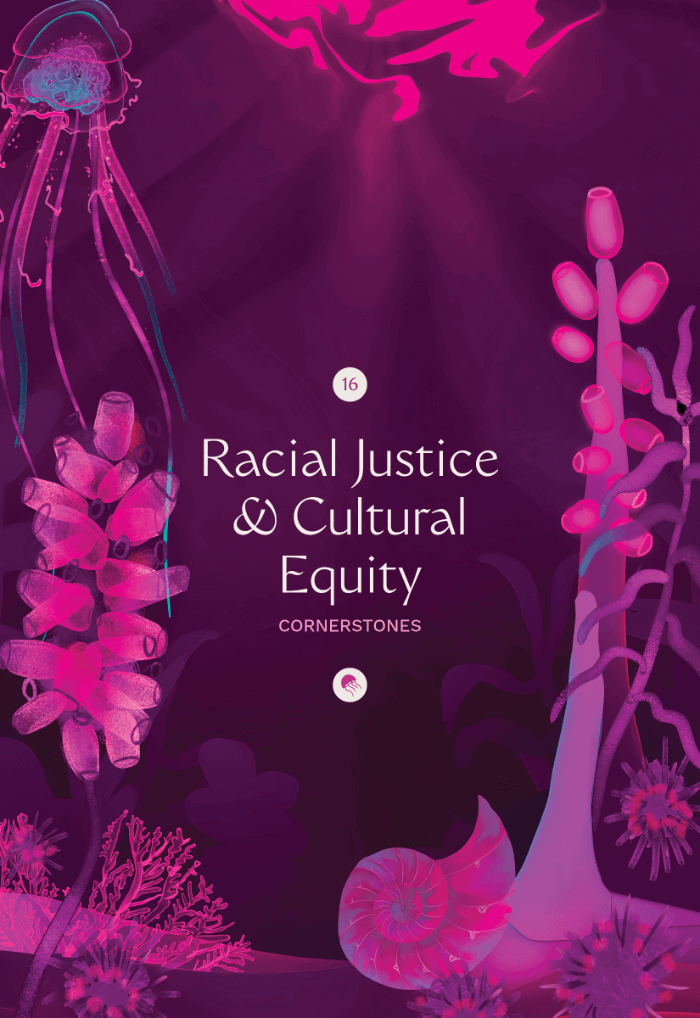 16
16Racial Justice & Cultural Equity
“Cultural suppression is [an] active and intentional part of white supremacy. We need everything to make real change—philosophical discourse, activism, and funding.”
—Natalia Neira Retamal, La Peña Cultural Center Racial Justice and Cultural Equity seek to transform civic, cultural, and political power using an awareness of histories of racial and cultural oppression to emphasize the cultural expressions, perspectives, and experiences of those most impacted by systems of oppression as essential for social transformation. Racial Justice and Cultural Equity guide us to:
- Take a historical perspective of current-day challenges
- Center the leadership of those most impacted by systems of oppression
- Recognize race as a primary compounding factor in oppression
- What stories are you telling? Whose lived experiences are being lifted up and given visibility? What is the message this sends?
- Based on that understanding, how is racial capitalism embedded in your work, organization, and/or sector? Who or what can support you in understanding this more fully?
- What ideologies, cultural practices, and policies have led to these current conditions?
16 -
Popular Education: Cornerstones
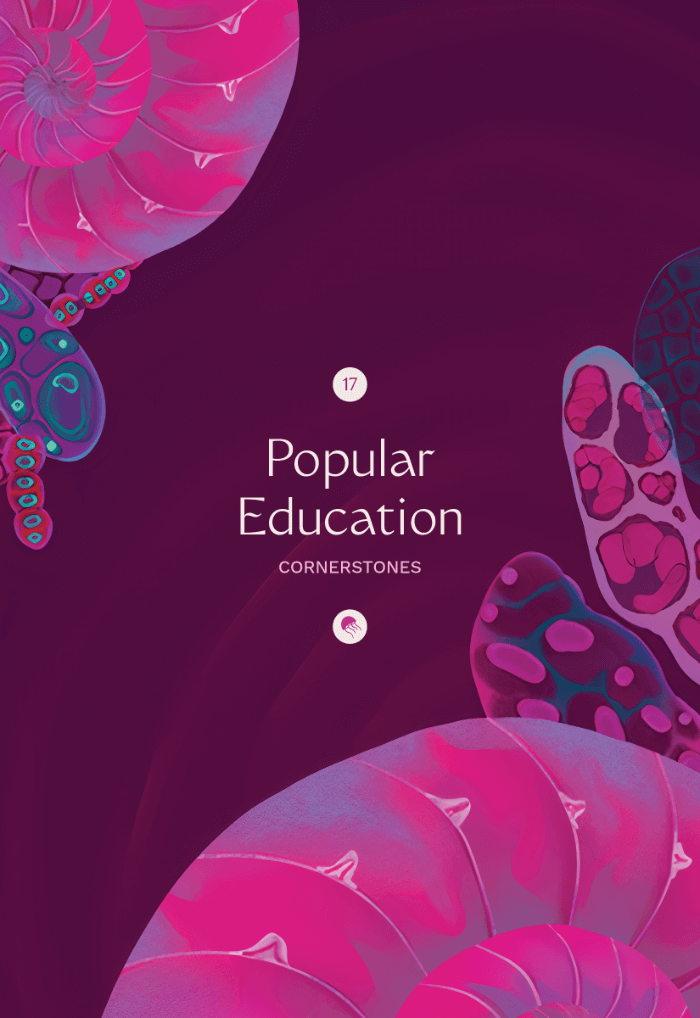 17
17Popular Education
“In order for authentic change to occur, we must be the drivers in our own culture, economies, and systems in our own ways. True equity will only be achieved through Native-led strategies of change. We must nurture the necessary community capacity to realize and participate in the change we seek.”
—Native American Community Development Institute (NACDI) Popular Education centers the knowledge and lived experiences of those most impacted by oppression. In this method, the people’s expertise guides cycles of critical reflection and action for liberation. Paulo Freire described popular education as “an educational approach that collectively and critically examines everyday experiences and raises consciousness for organizing and movement building, acting on injustices with a political vision in the interests of the most marginalized.” Popular Education guides us to:
- Recognize that people are the experts of their experience and should lead their own change processes
- Develop strategies and actions based on the strengths and culture of our organizations
- Recognize that solutions come from the community
- Engage radical dialects and create strategies based on root causes
- How does your organization center the lived experiences of your staff? Of your community?
- When you start from a place of strength, rooted in the experience of those in your organization, community, and networks, what strategies naturally emerge?
17 -
Design Justice: Cornerstones
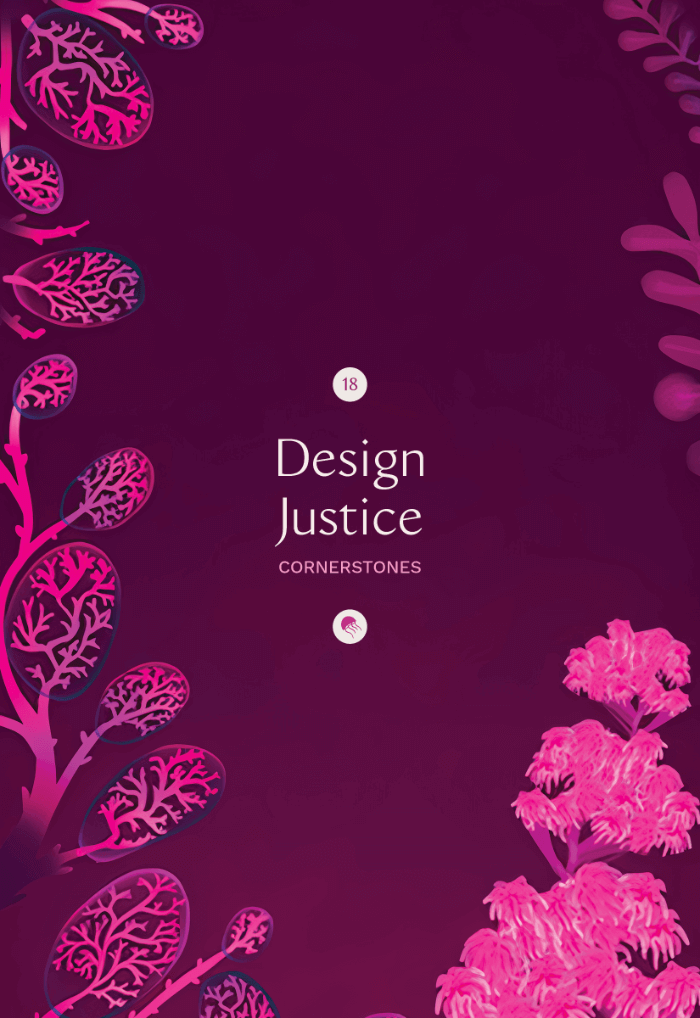 18
18Design Justice
“A people’s art is the genesis of their freedom.”
—Claudia Jones “In a kind of conventional, capitalist design process, the benefits disproportionately flow towards the people with the most power in the situation. And the harms are—the risks are—disproportionately borne by the people who have the least amount of power. So design justice hopes to distribute the risks and the rewards more equitably.”
—Una Lee, And Also Too And Design Justice Network Design Justice is a pedagogy that frames critical relationships and breaks down the hierarchies that white supremacy creates about knowledge and expertise. It is a framework that reminds designers, consultants, and anyone who creates structures and systems to find pathways that align with how people are already moving forward and builds from there. Design Justice is one of the ways we look at and restructure power in relationships.
- Who has the most expertise for the question at hand?
- How might shifting assumptions about style and creative “expertise” allow for true co-creation?
- How might you or your organization deepen efforts to share power and center relationships?
18 -
Cultivating Vulnerability: Liberating Practices
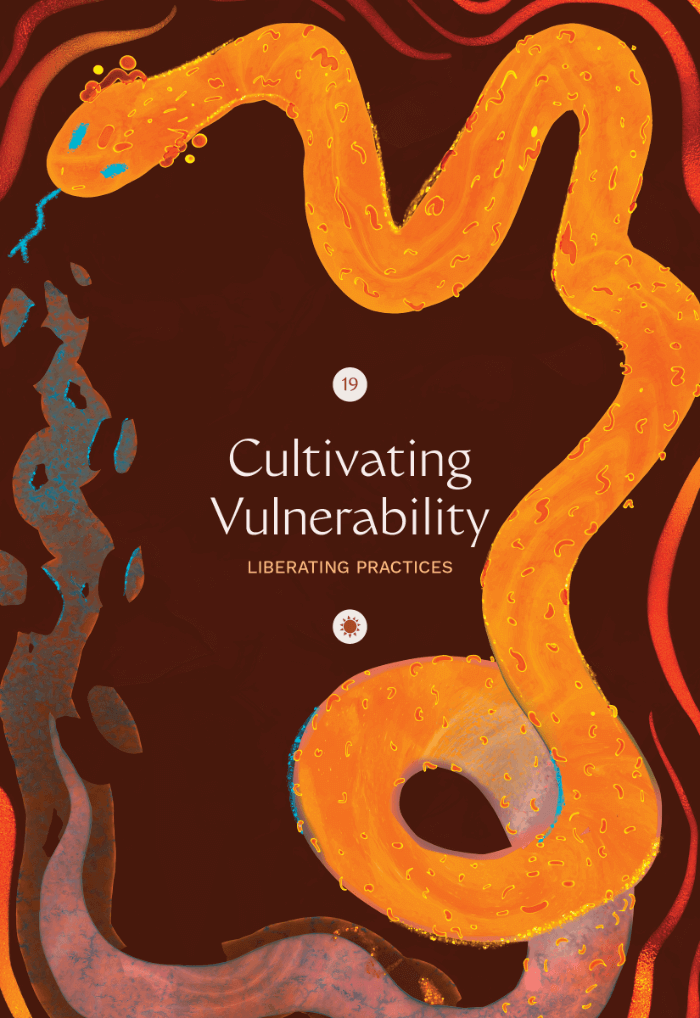 19
19Cultivating Vulnerability
“We want to cultivate vulnerability and be in that with each other yet the nonprofit industrial complex and philanthropy don’t allow for that. How do we step into new ways, elegant failures, and being vulnerable about learning and growth while we are in the current system?”
—Nina Yarbrough, Central District Forum For Arts & Ideas - How does vulnerability support your ability to disrupt current systems? How do systems of oppression show up in your efforts to be vulnerable together?
- How might we create a culture of vulnerability that disrupts white supremacy culture?
 ↑ Tension ↓
↑ Tension ↓ 
“How do I deepen my own humanity to become a leader of the newly envisioned organization? How do I become brave enough to embody what I envision… for staff, organization, and community? The leader can’t be the last one to do it.”
—Krys Holmes, The Myrna Loy Being vulnerable about our joys and challenges deepens relationships and the risk-taking necessary to leap towards a liberating future. Cultivating vulnerability takes the courage to root in one’s own truth while stretching beyond growth edges.
- How does vulnerability support you to move beyond our current systems, towards the next generative possibility and into your dreams?
19 -
Deepening Inner Work: Liberating Practices
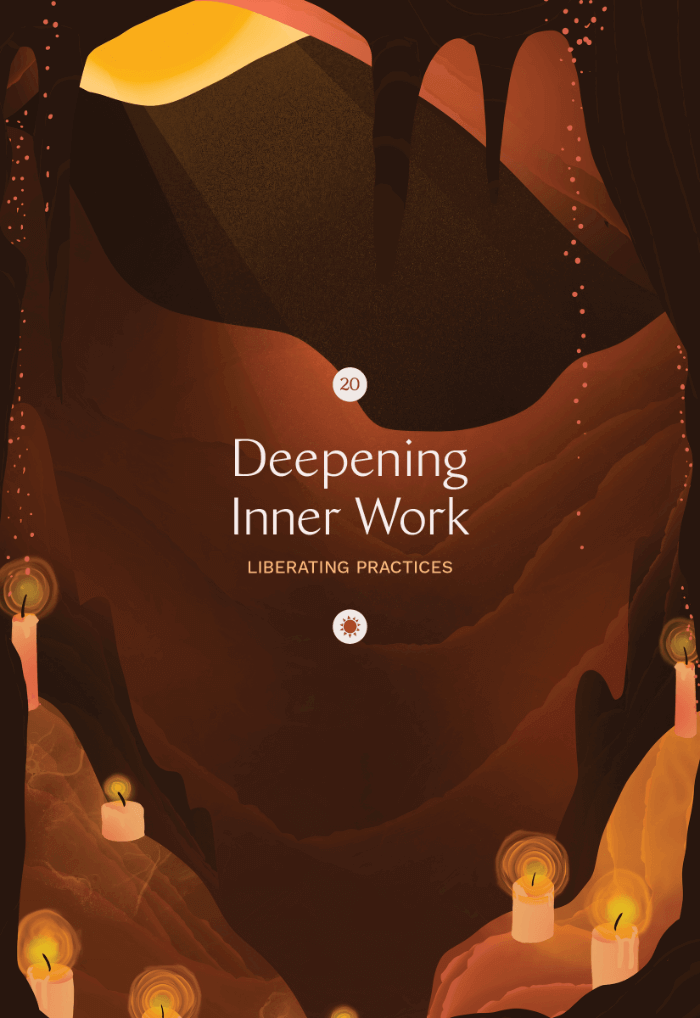 20
20Deepening Inner Work
“Without inner change, there can be no outer change. Without collective change, no change matters.”
—Rev. Angel Kyodo Williams “What does restoration look like for us? Restoration as well as reparation. For me, I can’t do this for however long—unless there’s a moment to be restored—and at the same time head institutional change and be accountable and try to sustain this [change].”
—Harold Steward, The Theater Offensive Our individual and collective practices of connecting to and nurturing ourselves—our health, emotions, and what is sacred to us—replenish and restore us. This inner work connects us with our purpose and supports us in being intentional about how we show up so that we can radically transform towards our vision.
- Take a few moments to connect your feet to the earth and breathe deeply. Feel the environment around you—the temperature, smells, sounds. Root in your interconnectedness to the trees, animals, plants—the ecosystem around you. What is the story of your full and interconnected humanity?
- What is sacred to you? What supports you to be intentional about how you show up with yourself and with others? How might you connect to that right now?
- What practices support the groups you’re a part of to connect to each other as individuals and as a group? What might you practice in this moment? What do you want to more deeply commit to?
20 -
Centering Creativity & Joy: Liberating Practices
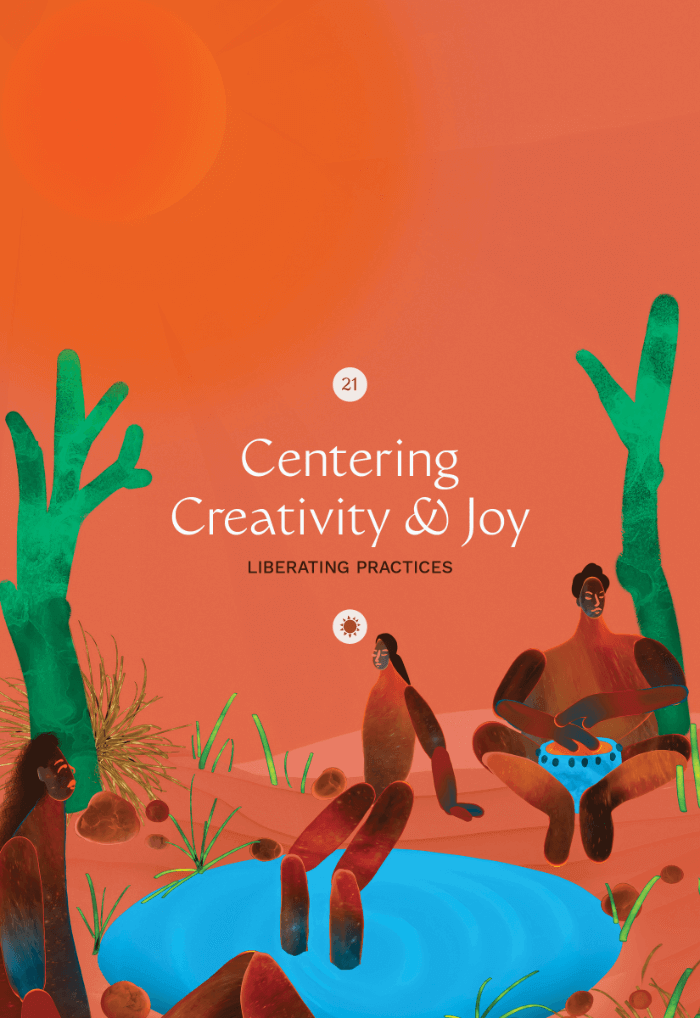 21
21Centering Creativity & Joy
“If what we need to dream, to move our spirits most deeply and directly toward and through promise, is a luxury, then we have given up the core—the fountain—of our power, our womanness; we have given up the future of our worlds.”
—Audre Lorde, “Poetry Is Not a Luxury” Joy restores us and grounds our bodies and our minds, enabling us to have courageous conversations and be in generative conflict together. When we laugh together, we can cry together too. Sharing our joys and heartaches through creative expression and play supports flexibility, adaptability, and sensing the many possibilities of the world we are co-creating. Hold space for making art, playing music, writing poetry, and playing together.
- How might you experience more joy today?
- How might creativity more deeply advance what you are working on?
- How might your team play your way to what is needed next?
21 -
Storytelling: Liberating Practices
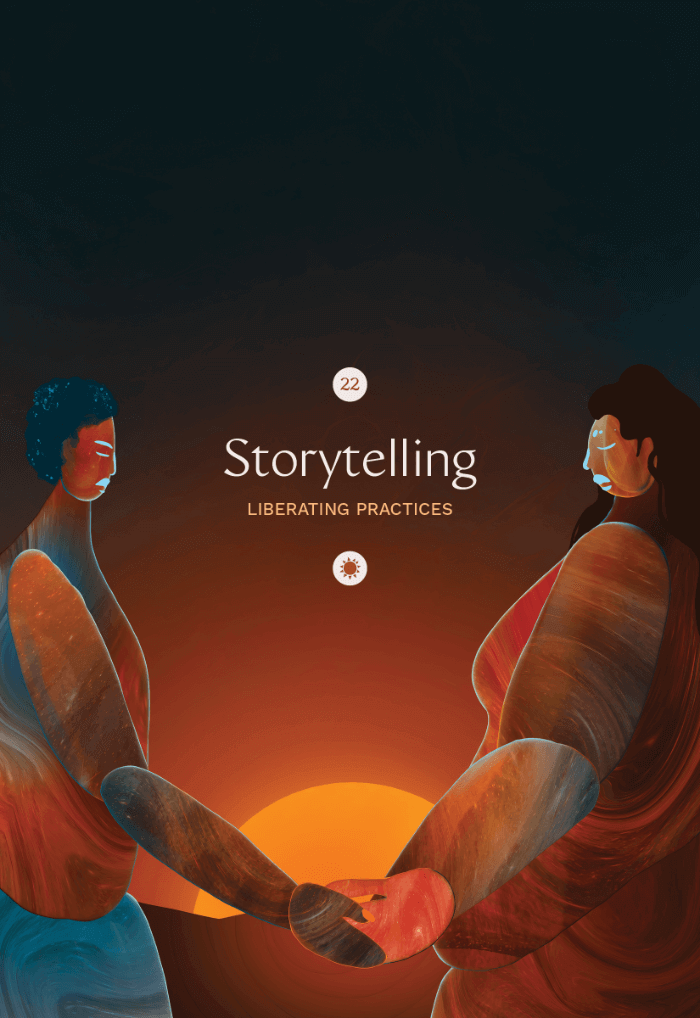 22
22Storytelling
“History is not the past. It is the stories we tell about the past. How we tell these stories—triumphantly or self-critically, metaphysically or dialectically—has a lot to do with whether we cut short or advance our evolution as human beings.”
—Grace Lee Boggs We understand the world through the stories we tell each other; through the stories that are told to us. Stories are woven from experience, creativity, and narratives—the collective messages we hear from our communities, cultures, lineages, as well as the oppressive systems we are in. It matters who is doing the storytelling, and there is magic and power in weaving our own liberated narratives to prefigure our desired world.
- What stories do you carry with you? How do they nourish you and your relationships? How do they create barriers to deepening your sense of self and your relationships?
- What narratives—chosen or not—contribute to your stories?
- What stories are emerging for you? For your organization? For your community?
22 -
Connecting to Our Bodies: Liberating Practices
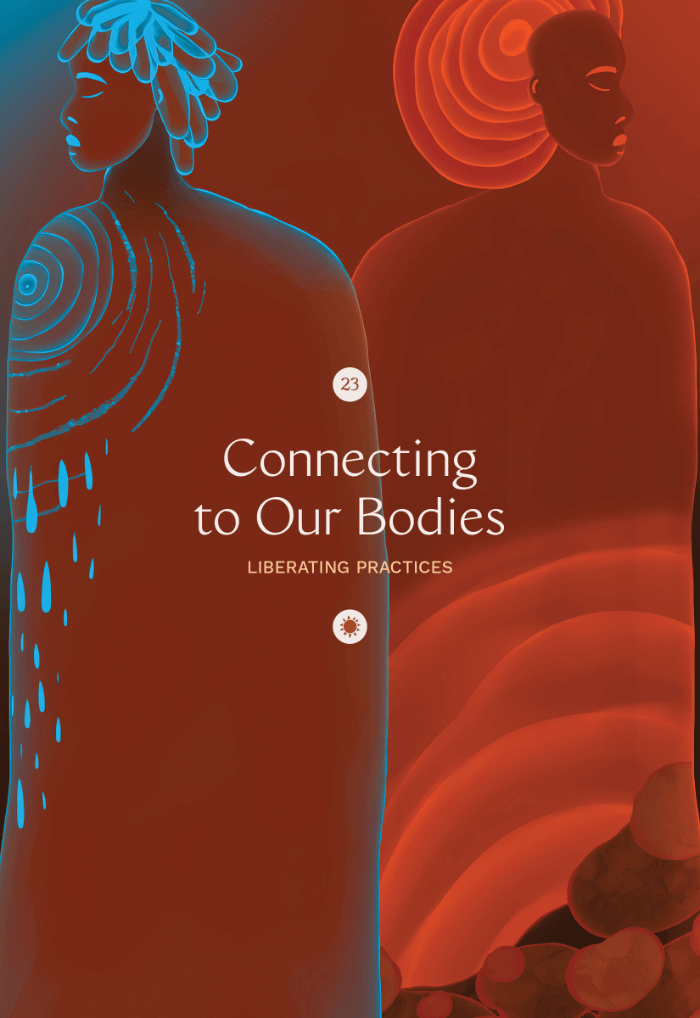 23
23Connecting to Our Bodies
White supremacy culture often asks us to divorce ourselves from our bodies—severing our connection to the way it feels, the relationships it has with others, and the formations or shapes that we ask of it in order to proceed through life. A part of practicing inner work and building power for strong and equitable arts organizations is relearning and trusting the ways in which our bodies tell the stories.*
- What do you feel right now? Where do you experience that feeling in your body? What is the story there?
- How might you be feeling stuck? How might you be feeling generative? What story is your body telling about this moment?
* Informed by the work of Monica Dennis.
23 -
Embracing Network Practices: Liberating Practices
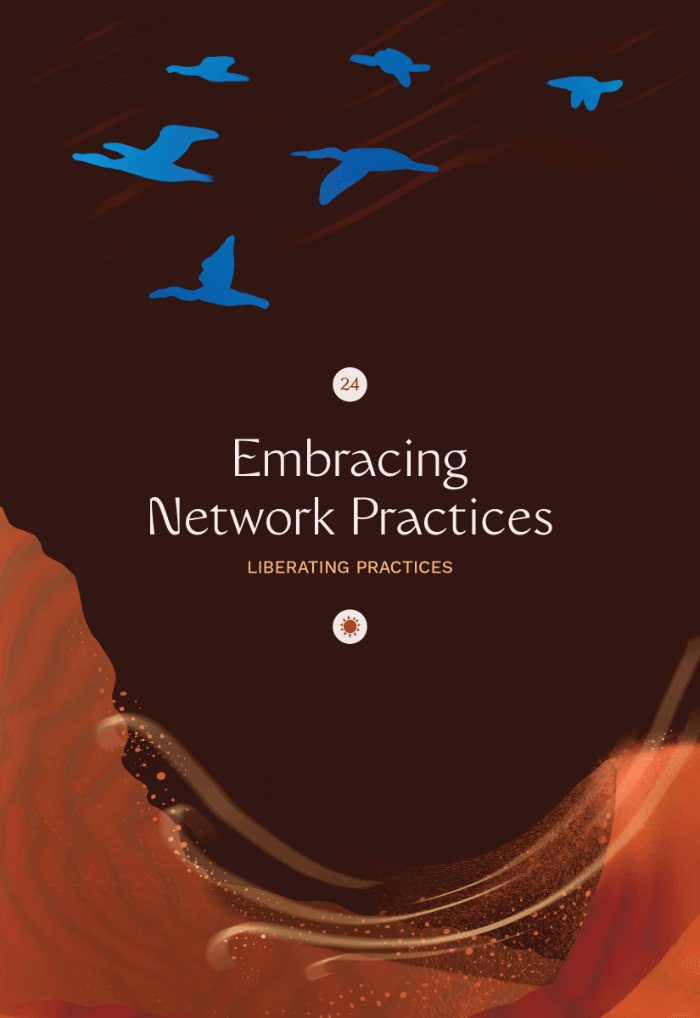 24
24Embracing Network Practices
“The retreats resulted in an ongoing network among those who participated in them… The reason I thought of us having retreats… [was] because I was getting to go and meet people in various places, who were Black feminists. And I just thought, we need to kind of organize this and institutionalize this. Not in the sense of being a bureaucracy, but we need to figure out a way that the experiences I was having—because they were so valuable—and the opportunities to meet other Black feminists, we needed to do that in an organized fashion.”
—Barbara Smith, How We Get Free: Black Feminism and the Combahee River Collective The simple art of gathering in shared purpose and values is central to the rich history of racial justice and liberation struggles. Maroon communities living outside of slave societies, Reconstruction-era schools, the Pan African Congresses, student resistance movements, and convenings have all driven forth new institutions, new tactics, and new possibilities for cultural movements. Networks rooted in collective values are interdependent, mutually supportive and accountable, and very relational. They deepen mindsets and practices of abundance rather than scarcity, collaboration rather than competition, and connection rather than isolation.
- What values guide you? What values guide the networks you are a part of?
- Ask the networks you are in: What nourishes us? What might we need to tend to in support of our vision?
- How are you collectively redistributing power and resources in ways that shift systems towards racial justice and cultural equity?
24 -
Nourishing Beautiful Connections: Liberating Practices
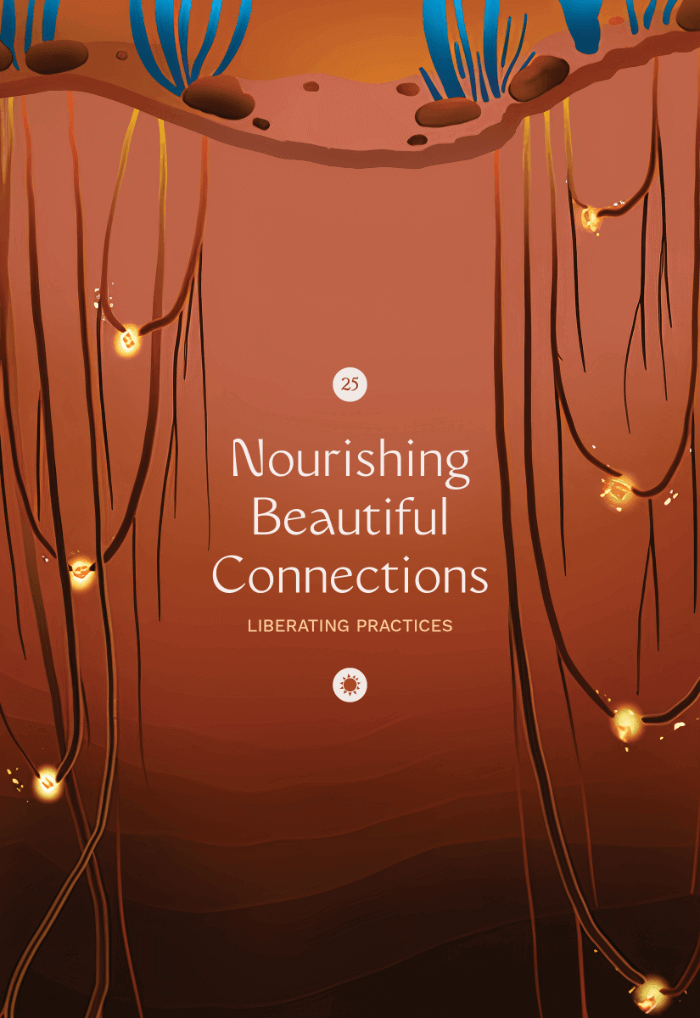 25
25Nourishing Beautiful Connections
“Remember: Oppression thrives off isolation. Connection is the only thing that can save us.”
—Yolo Akili Centering transformational, equitable, deep relationships—ones that have the capacity for nourishing ourselves and each other—creates the conditions for long-lasting collaboration towards racial justice and cultural equity. Rooted in our interdependence, we can build these beautiful connections by recognizing everyone’s full humanity, stepping into each other’s journeys, holding boundaries, deepening trust, and resourcing in one another, tapping into the depths of our communities. It is through these beautiful connections that we create the culture of the world we want.
- What are your interdependent pathways for creating deep and beautiful connections?
- When do you feel alone in the work? What relationships would help heal that isolation?
- How do you hold boundaries with yourself, your organization, and your community while building trust and sharing your joys and challenges?
25 -
Failing: Liberating Practices
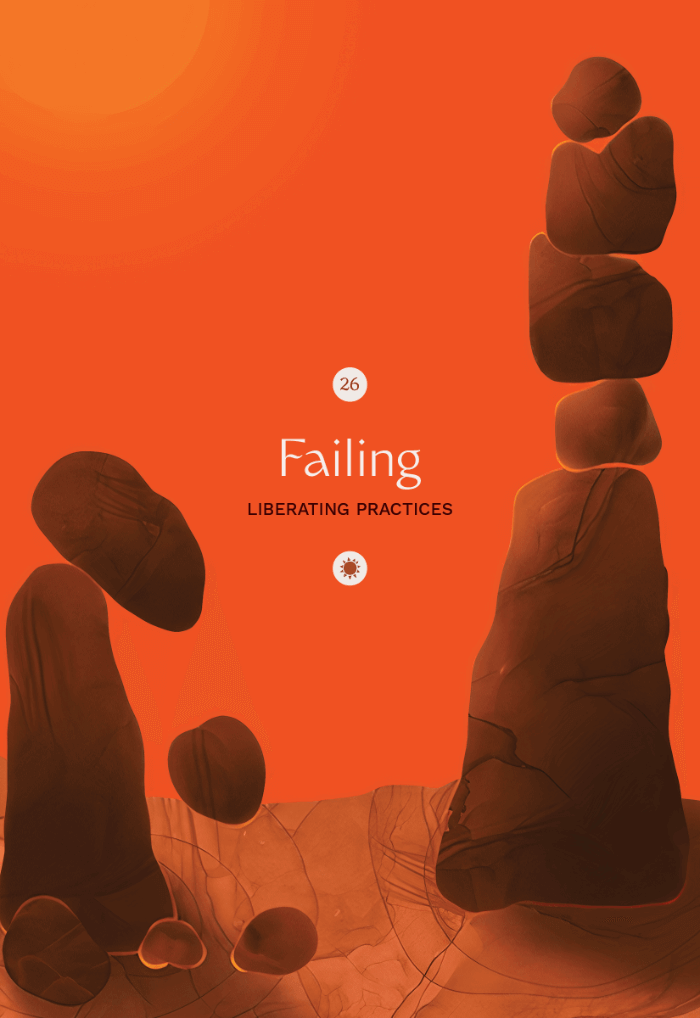 26
26Failing
“Transformation in leadership and self is made possible by creating space for reflection on experiences, including success and mistakes and risk-taking. Part of this is not letting fear of failure [make you feel stuck] but using it as an opportunity to learn more deeply and continue to iterate towards our vision.”
—Lane Cohort Member “Art helps understand facing fear, like with falling exercises as a dancer. There’s an art to messing up and coming out of it. It’s not just an analogy, it actually is something physically that I’ve found has helped me move through some of these things.”
—Stephanie Mckee-Anderson, Junebug Productions - What supports you in moving through failures and mistakes?
- What failures have sparked new growth and possibilities?
- Visualize a time when you learned something that truly stuck with you. What was the situation? What was transforming about it? What failures were you open to? What failures might have guided you?
26 -
Healing: Liberating Practices
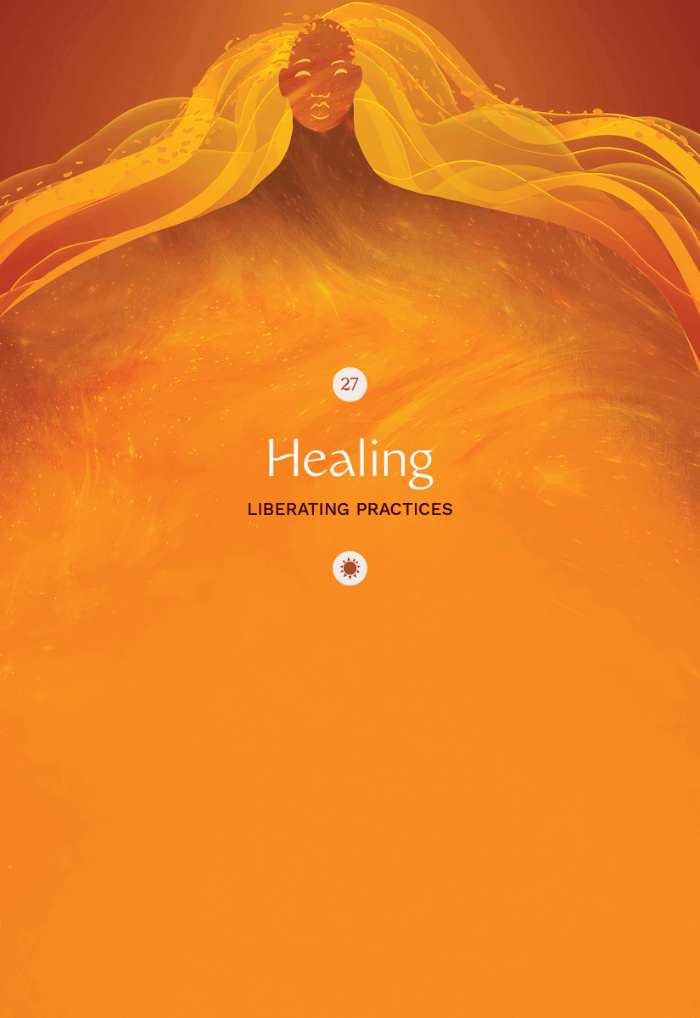 27
27Healing
“All you need is in your bones.”
—Nayo Watkins Solutions are best when generated by those with the most firsthand experience. To build meaningful bridges for shared meaning-making and problem-solving, we must deepen our connections to ourselves and each other; this is feeling and healing work. As Prentis Hemphill shares, “Healing makes room for us to fight in the places where it is necessary and love in the places we long to.”
Do you feel?
Yes, I feel.
Do you feel?
Yes, I feel.
Your heart needs your attention, right here.
Do you heal?
Yes, I heal.
Do you heal?
Yes, I heal.
We’ve got all our medicines, right here.—Co-Written By Lu Aya Nephew & The Peace Poets, Akua Smith, and Lex Barlowe … Sing it with us!
- What are you feeling?
- Where does your heart need attention?
- What medicines do you have to apply to what needs healing?
27 -
Leading Together: Liberating Practices
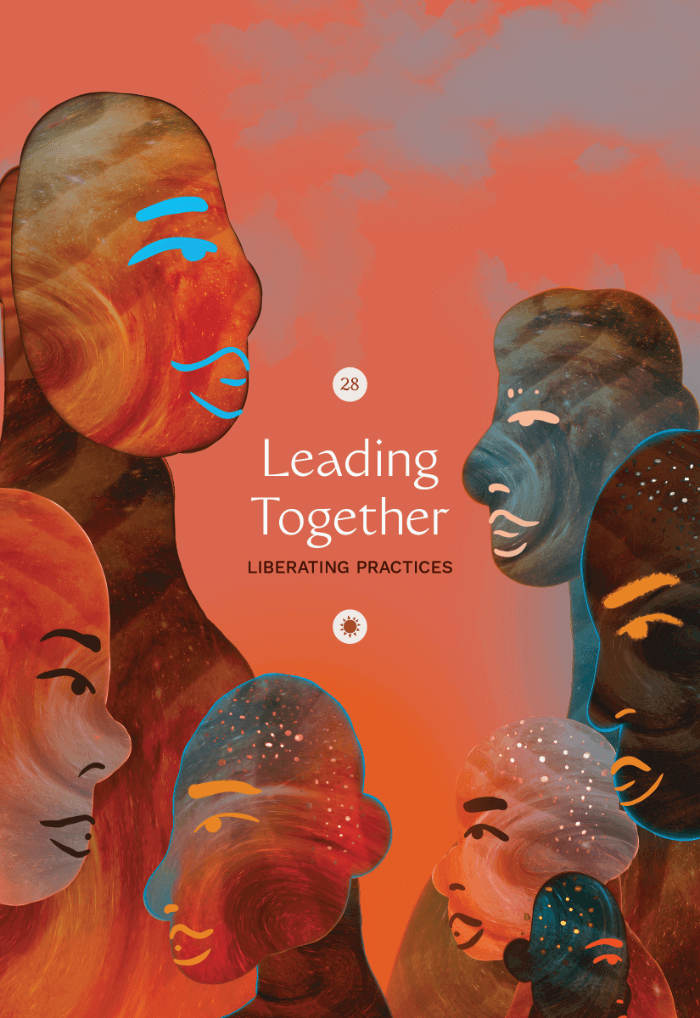 28
28Leading Together
Leading toward racial justice and cultural equity expands what leadership looks like in practice, shifting to a model of shared leadership that centers the relationships between people leading together from their purpose and towards a shared vision. Like dancing, shared leadership embraces many approaches and requires self-awareness—knowing your part or purpose, trusting in your own and your co-leaders’ capacity, and cultivating the ability to flex approaches, or moves, in balance with others.
- Put on some music and try out the moves that capture your leadership. What is your leadership dance called? What do these moves tell you about your approach to shared leadership?
 ↑ Tension ↓
↑ Tension ↓ 
“Inner work is necessary for a strategic shift to a shared leadership culture.”
—Beatrice Thomas, Lane Consultant Shared leadership requires principled struggle—generative conflict with a strong analysis of power, gender, ability, race, and other dimensions of difference. In shared leadership, we ask: Who is leading and why? How are we making decisions? Individual and collective practices of inner work support us to show up in these questions with connection to purpose and values.
- What supports you and your teams to stay connected to purpose and values while navigating the hard parts of shared leadership?
28